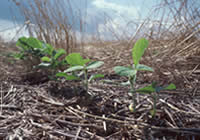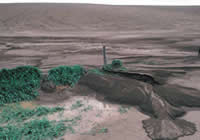| Environmental Benefits of Conservation Management |
| Adoption of conservation practices has significant environmental benefits on farms and those benefits extend to surrounding lands. |
| Carbon Sequestration – practices such as conservation tillage and setting-aside cropland from production in the Conservation Reserve Program increases carbon storage in the soil, mitigating the greenhouse effect |
 Photo courtesy of USDA-NRCS
Photo courtesy of USDA-NRCS |
| Improves soil characteristics - including structure, organic matter content, soil microbial activity, and fertility |
| Reduces Soil Erosion - Field studies comparing moldboard plowing to no-till on highly erodible lands found that no-till reduced soil erosion by over 90%. Setting-aside land from production has also been found to reduce erosion on former croplands, particularly those on steeper slopes . |
| Increases Soil Moisture – conservation practices can also enhance water infiltration with improved soil structure, increasing soil moisture availablility to crops |
| Enhances Wildlife Habitat – set-aside lands in the Conservation Reserve Program can provide critical habitat for wildlife |
| Environmental Influences on the Decisions to Adoption Conservation Practices |
| Practical experience and extensive site-level research has demonstrated that climate, soils, topography and other environmental factors influence land use and management decisions, such as selection of crops, fertilizer rates, pesticide and herbicide use. Adoption of conservation practices are no exception including implementation of no-till management or setting-aside land from production in a conservation program. |
 Photo courtesy of USDA-NRCS
Photo courtesy of USDA-NRCS |
No-till management – Climate and soil conditions influence decisions to adopt no-till management due to enhanced residue cover. In dry climates, farmers often adopt no-till because of greater moisture availability with less evaporation under the residue cover. In colder climates, however, a build-up of residues on soils can slow soil warming in the spring, delaying seed germination and reducing yields. The amount of build-up depends on the crop, but farmers sometimes decide to not adopt no-till practices because of limitations to crop productivity with an “effectively” shorter growing season. |
| Conservation Reserve Program – Decisions to set-aside land from production are also influenced by climate, soil and topographic position. Lowland areas under moist climate conditions are typically more productive than marginal croplands in drier regions or steeper slopes. Producers are often more willing to set-aside lands that are marginal due to lower crop yields. In addition, policy may restrict eligibility to highly erodible lands with the goal of reducing soil erosion. |
|







